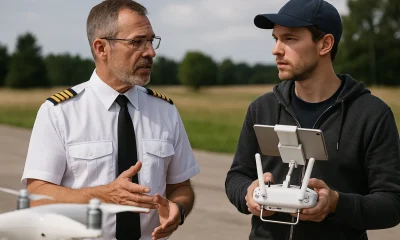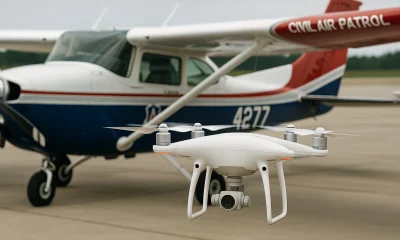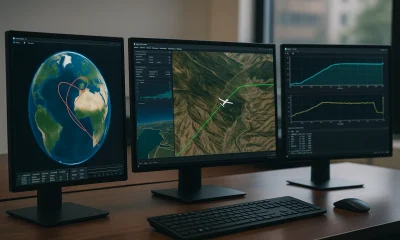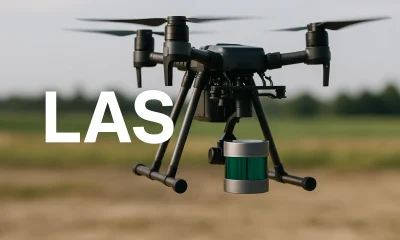- Acronym Guide
- AAM
- ABS
- AC
- ACAS
- ADS-B
- AFAC
- AGL
- AI
- AIM
- ALS
- AM
- AMA
- ANSP
- AOI
- APPI
- AUV
- AUVSI
- ARPAS-UK
- ASTM
- ATC
- BVLOS
- CAA
- CAAC
- CAB
- CAP
- CASA
- CATT
- CBO
- CBR
- CBRN
- CDMA
- CDR
- CFI
- CFR
- CIR
- COA
- COMINT
- CORS
- COTP
- COTR
- CPTED
- CV
- C2
- DAA
- DEM
- DFI
- DFS
- DGCA
- DHS
- DOD
- DPA
- DPEs
- DRG
- DRO
- DSM
- DSMX
- DSP
- DSSS
- DTM
- EASA
- EFT
- EO
- EOD
- EO/IR
- ELINT
- EMI
- ESC
- EVLOS
- eVTOLs
- FAA
- FCC
- FCS
- FHSS
- FICCI
- FLIR
- FOB
- FOV
- FPS
- FPV
- GBDAA
- GCP
- GCS
- GDPR
- GML
- GNSS
- GPS
- GSD
- GVC
- HDR
- HOGE
- IACRA
- ICAO
- ICS
- IMU
- INS
- IR
- ISA
- ISR
- ITU
- JARUS
- LAAMS
- LAANC
- LAATM
- LAI
- LAS
- LBA
- LIDAR
- LOS
- LSALT
- MAC
- MAVLink
- MLIT
- MMS
- MSL
- MTOM
- NDAA
- NCSL
- NFZ
- NIST
- NMEA
- NOTAM
- NPA
- NPRM
- NTIA
- OBIA
- OEM
- OFDM
- OOP
- PASM
- PAV
- PCV
- PdM
- PEC
- PIC
- PID
- PIPL
- PLD
- PM
- PN
- PPK
- PPS
- PSM
- PWM
- UAM
- UAOP
- UAS
- UASTM
- UAV
- UCAVs
- UHD
- UHF
- USV
- UTM
- RAIM
- RCC
- RCS
- RFI
- ReOC
- RePL
- RMS
- ROI
- RPAS
- RPC
- RTH
- RTN
- RTK
- SaR
- SAR
- SARP
- SBAS
- S.Bus
- SBIR
- SEDENA
- SfM
- SFOC
- SIGINT
- SLAM
- SMS
- SOP
- SORA
- STANAG
- STTR
- STK
- sUAS
- TCAS
- TCCA
- TFR
- TIN
- TOF
- TP
- TPS
- TSA
- VHF
- VLOS
- VTOL
Drone Acronyms
What is EOD (Explosive Ordnance Disposal) & How Does it Work?
Published
2 months agoon
By
Jacob StonerTable Of Contents

Definition
EOD, or Explosive Ordnance Disposal, refers to the specialized process of detecting, identifying, disarming, and disposing of explosive devices. In drone applications, EOD operations utilize unmanned aerial systems to safely assess and support the neutralization of improvised explosive devices (IEDs), unexploded ordnance (UXO), and other hazardous materials without exposing personnel to direct danger.
Usage
Military, police, and bomb squads deploy drones in EOD missions to perform aerial reconnaissance, thermal scanning, 3D mapping, and delivery of detonation tools or sensors. These drones help inspect suspicious packages, investigate blast zones, or deliver payloads for remote disruption of threats—all while keeping the EOD technician out of harm’s way.
Relevance to the Industry
Drones are transforming EOD procedures by providing standoff capabilities, minimizing exposure risk, and increasing mission speed. EOD-capable drones are often outfitted with HD zoom cameras, robotic arms, radiation detectors, or payload drop mechanisms. Their adoption continues to grow across military zones, border regions, public event security, and even critical infrastructure inspections.
How Does EOD (Explosive Ordnance Disposal) Work?
Explosive Ordnance Disposal (EOD) drones are designed to support bomb disposal operations by providing remote inspection, threat identification, and payload delivery without endangering personnel. These drones serve as an essential first line of reconnaissance in high-risk environments. Here’s how EOD drone operations typically work:
Pre-Mission Assessment and Launch
When a suspicious device or explosive threat is identified, EOD teams deploy a drone from a secure perimeter. The drone is selected based on the threat type, required sensor payloads, and mission distance. Quick-launch multirotor drones are most commonly used for rapid deployment in confined or urban areas.
Aerial Reconnaissance and Visual Identification
Using HD zoom or 4K cameras, the drone provides live video back to the command unit. EOD specialists use the feed to visually assess the device, identify wiring, triggering mechanisms, or suspicious objects, and determine the level of threat. Some drones also carry infrared or thermal sensors for detecting heat signatures from electronic components.
Payload Delivery or Manipulation
Advanced EOD drones are equipped with modular payload systems. Depending on the situation, the drone may:
Deliver small explosive charges for controlled detonation
Deploy disruption tools such as directed water cannons
Drop or attach sensors (e.g., radiation detectors or acoustic devices)
Place robotic arms to reposition or manipulate objects remotely
Threat Neutralization or Clearance
After assessment, the EOD technician may initiate a controlled detonation or disruption via remote commands. In some cases, drones are used to verify that a threat has been neutralized before personnel are allowed to approach the site.
Post-Incident Mapping and Documentation
Once cleared, the drone may conduct a secondary flight to document the site, map blast effects, or support forensic data collection. This helps in creating post-operation reports or for evidence in investigations involving criminal or terrorist activity.
By integrating UAVs into EOD workflows, bomb disposal teams significantly reduce exposure to threats while improving speed, accuracy, and safety in critical missions.
Example in Use
“An EOD team deployed a drone equipped with a robotic manipulator to inspect and safely detonate a suspected IED near the roadside checkpoint.”
Frequently Asked Questions about EOD (Explosive Ordnance Disposal)
How are drones used in EOD operations?
Answer:
For visual inspection of suspicious devices from a safe distance.
To deliver sensors or robotic tools to an explosive site.
To assist in remote detonation or data relay during a disruption.
For thermal or radiation scanning around UXO or chemical explosives.
Who uses EOD drones?
Answer:
Military bomb disposal units in combat zones.
Civilian law enforcement bomb squads.
Emergency response teams handling UXO after natural disasters.
Security teams protecting public events and VIP sites.
What are the benefits of using drones in EOD missions?
Answer:
Safety: Removes personnel from blast zones.
Speed: Immediate deployment and rapid area scans.
Precision: Pinpoint views of the threat and efficient tool delivery.
Documentation: Captures real-time data for post-incident analysis.
For examples of these acronyms visit our Industries page.
As the CEO of Flyeye.io, Jacob Stoner spearheads the company's operations with his extensive expertise in the drone industry. He is a licensed commercial drone operator in Canada, where he frequently conducts drone inspections. Jacob is a highly respected figure within his local drone community, where he indulges his passion for videography during his leisure time. Above all, Jacob's keen interest lies in the potential societal impact of drone technology advancements.
Pros
Cons
You may like


What is CFI (Certified Flight Instructor) & How Does it Work?


What is CAP (Civil Air Patrol) & How Does it Work?


What is STK (Systems Tool Kit) & How Does it Work?


What is SOP (Standard Operating Procedure)?


What is RTN (Real-Time Network) & How Does it Work?


What is LAS – Laser (LiDAR) File Format & How Does it Work?